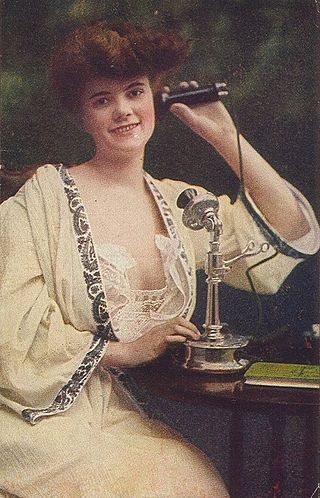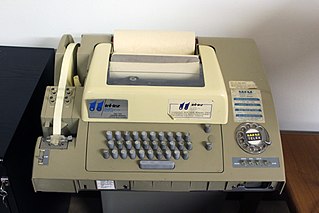Related Research Articles

A telephone switchboard was a device used to connect circuits of telephones to establish telephone calls between users or other switchboards, throughout the 20th century. The switchboard was an essential component of a manual telephone exchange, and was operated by switchboard operators who used electrical cords or switches to establish the connections.
Title 47 CFR Part 68 is a section of the Code of Federal Regulations of the United States that regulate the direct electrical connection of telecommunications equipment and customer premises wiring with the public switched telephone network, certain private line services, and connection of private branch exchange (PBX) equipment to certain telecommunication interfaces.
Telephony is the field of technology involving the development, application, and deployment of telecommunication services for the purpose of electronic transmission of voice, fax, or data, between distant parties. The history of telephony is intimately linked to the invention and development of the telephone.

A blue box is an electronic device that produces tones used to generate the in-band signaling tones formerly used within the North American long-distance telephone network to send line status and called number information over voice circuits. This allowed an illicit user, referred to as a "phreaker", to place long-distance calls, without using the network's user facilities, that would be billed to another number or dismissed entirely as an incomplete call. A number of similar "color boxes" were also created to control other aspects of the phone network.

A telephone call or telephone conversation, also known as a phone call or voice call, is a connection over a telephone network between the called party and the calling party. Telephone calls started in the late 19th century. As technology has improved, a majority of telephone calls are made over a cellular network through mobile phones or over the internet with Voice over IP. Telephone calls are typically used for real-time conversation between two or more parties, especially when the parties cannot meet in person.
Subscriber trunk dialling (STD), also known as subscriber toll dialing, is a telephone numbering plan feature and telecommunications technology in the United Kingdom and various Commonwealth countries for the dialling of trunk calls by telephone subscribers without the assistance of switchboard operators.
The public switched telephone network (PSTN) is the aggregate of the world's telephone networks that are operated by national, regional, or local telephony operators. It provides infrastructure and services for public telephony. The PSTN consists of telephone lines, fiber-optic cables, microwave transmission links, cellular networks, communications satellites, and undersea telephone cables interconnected by switching centers, such as central offices, network tandems, and international gateways, which allow telephone users to communicate with each other.
In telecommunications, trunking is a technology for providing network access to multiple clients simultaneously by sharing a set of circuits, carriers, channels, or frequencies, instead of providing individual circuits or channels for each client. This is reminiscent to the structure of a tree with one trunk and many branches. Trunking in telecommunication originated in telegraphy, and later in telephone systems where a trunk line is a communications channel between telephone exchanges.
A telephone numbering plan is a type of numbering scheme used in telecommunication to assign telephone numbers to subscriber telephones or other telephony endpoints. Telephone numbers are the addresses of participants in a telephone network, reachable by a system of destination code routing. Telephone numbering plans are defined in each of the administrative regions of the public switched telephone network (PSTN) and in private telephone networks.

A business telephone system is a telephone system typically used in business environments, encompassing the range of technology from the key telephone system (KTS) to the private branch exchange (PBX).
Verizon New York, Inc., formerly The New York Telephone Company (NYTel), was organized in 1896, taking over the New York City operations of the American Bell Telephone Company.
Permanent signal (PS) in American telephony terminology, or permanent loop in British usage, is a condition in which a POTS line is off-hook without connection for an extended period of time. This is indicated in modern switches by the silent termination after the off-hook tone times out and the telephone exchange computer puts the telephone line on its High & Wet list or Wetlist. In older switches, however, a Permanent Signal Holding Trunk (PSHT) would play either an off-hook tone or a 480/500 Hz high tone. Off-hook tone is a tone of increasing intensity that is intended to alert telephone users to the fact that the receiver has been left off the hook without being connected in a call. On some systems before the off-hook tone is played, an intercept message may be announced. The most common message reads as follows; "If you'd like to make a call, please hang up and try again. If you need help, hang up and then dial your operator."
In telephony, ground start is a method of signaling from a terminal of a subscriber local loop to a telephone exchange, where one side of a cable pair is temporarily grounded to request dial tone. Most middle 20th-century American payphones used coin-first ground start lines, with the starting ground connection provided by the coin itself, bridging a set of contacts as it passed through the coin chute.
The Number Five Crossbar Switching System is a telephone switch for telephone exchanges designed by Bell Labs and manufactured by Western Electric starting in 1947. It was used in the Bell System principally as a Class 5 telephone switch in the public switched telephone network (PSTN) until the early 1990s, when it was replaced with electronic switching systems. Variants were used as combined Class 4 and Class 5 systems in rural areas, and as a TWX switch.
A class-4, or tandem, telephone switch is a U.S. telephone company central office telephone exchange used to interconnect local exchange carrier offices for long distance communications in the public switched telephone network.

A telephone number is a sequence of digits assigned to a landline telephone subscriber station connected to a telephone line or to a wireless electronic telephony device, such as a radio telephone or a mobile telephone, or to other devices for data transmission via the public switched telephone network (PSTN), or other public and private networks. Modern smart phones have added a built-in layer of abstraction whereby individuals or businesses are saved into a contacts application and the numbers no longer have to be written down or memorized.
Ringing is a telecommunication signal that causes a bell or other device to alert a telephone subscriber to an incoming telephone call. Historically, this entailed sending a high-voltage alternating current over the telephone line to a customer station which contained an electromagnetic bell. It is therefore also commonly referred to as power ringing, to distinguish it from another signal, audible ringing, or ringing tone, which is sent to the originating caller to indicate that the destination telephone is in fact ringing.

A telephone exchange, also known as a telephone switch or central office, is a crucial component in the public switched telephone network (PSTN) or large enterprise telecommunications systems. It facilitates the interconnection of telephone subscriber lines or digital system virtual circuits, enabling telephone calls between subscribers.

Telex is a telecommunication service that provides text-based message exchange over the circuits of the public switched telephone network or by private lines. The technology operates on switched station-to-station basis with teleprinter devices at the receiving and sending locations. Telex was a major method of sending written messages electronically between businesses in the post–World War II period. Its usage went into decline as the fax machine grew in popularity in the 1980s.
Wawina is an unincorporated community in Wawina Township, Itasca County, Minnesota, United States.
References
- ↑ Atis, Tie Trunk , retrieved 2015-06-08
- ↑ YourDictionary.com, American Heritage Dictionary, YourDictionary.com: Tie Line, archived from the original on 2007-06-20, retrieved 2015-06-07